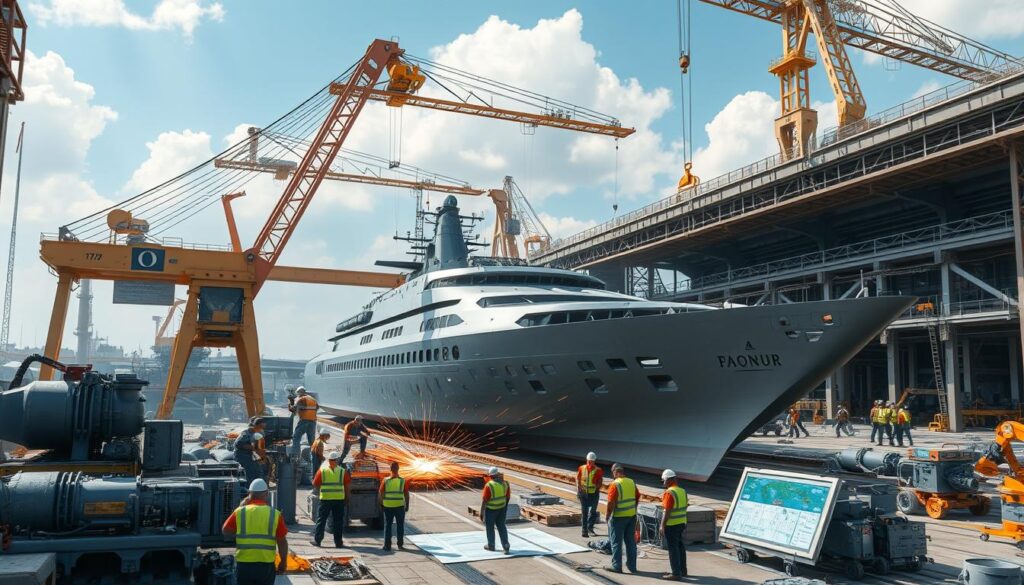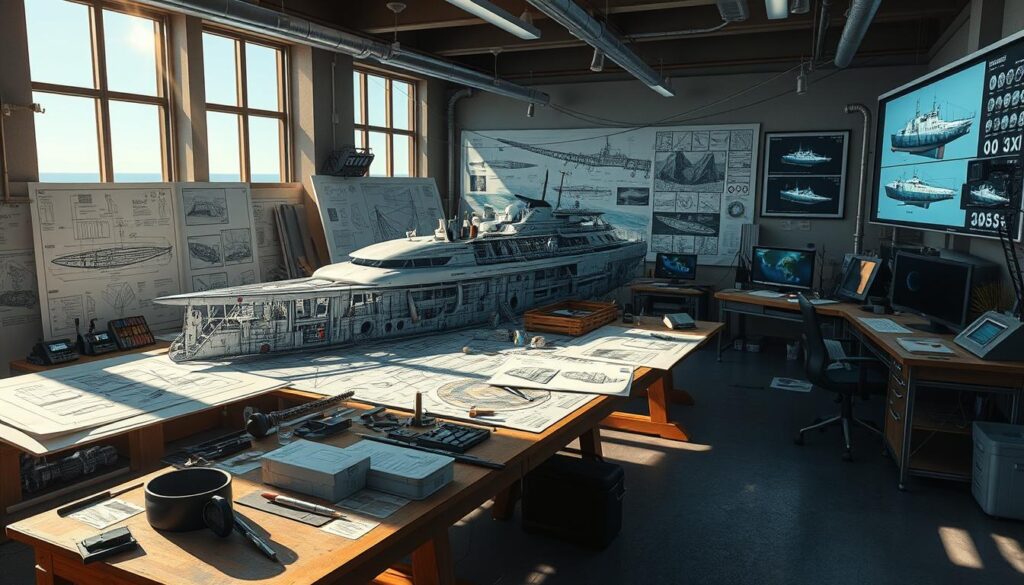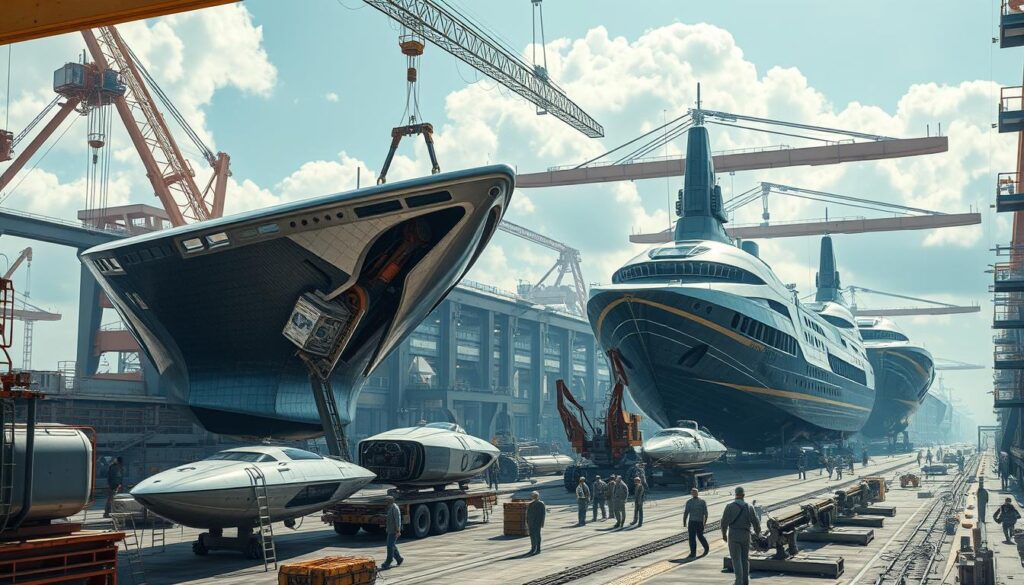-
 Call Now ! +86-13912367818
Call Now ! +86-13912367818 -
 Email Now info@wxhlhg.com
Email Now info@wxhlhg.com


Explore the intricate process of ship construction, where modern shipbuilding techniques meet maritime engineering to create robust sea vessels.
Building ships is key to global trade. American shipyards, like General Dynamics NASSCO, lead in maritime engineering. They turn steel into huge ships. These giants sailed the oceans, carrying essential goods1.
Shipbuilders must figure out how much a ship can carry. This includes cargo, fuel, and stores2. They also calculate gross tonnage to know a ship's space. Net tonnage shows how much money a ship can make2.
Designers work hard to make sure ships are stable in water2. Shipyards use smart ways to build many ships at once, saving money2. Many skilled workers, led by top managers, make this happen. They work on everything from steel to electrical systems2.
Ships are vital for global trade, carrying most of the world's goods1. They start in shipyards and make a big splash when launched into the sea. This shows the power and skill of shipbuilding.
● The scale and precision in ship construction are emblematic of rigorous maritime engineering efforts.
● Prefabrication and meticulous planning are keys to efficiency and cost reduction in shipbuilding.
● Gross and net tonnage, along with deadweight, are critical metrics guiding vessel construction.
● Diverse teams and skilled labor pools drive the successful execution of complex shipbuilding projects.
● Shipyards are strategically designed to enable the seamless assembly and launching of massive vessels.
● Ships play an essential role in the global economy by transporting over 90% of internationally traded goods.

Creating modern ships is a peak of engineering excellence and tech use. Our shipyard uses advanced marine construction methods and expertise. This is to meet the needs of global trade and defense.
Building ships is tough, from design to final outfitting. Most ships today are made of steel for its strength. The use of 3D Printing for small, detailed parts is growing3. Robots help in welding and painting, making work safer and more efficient3. We're also focusing on using eco-friendly materials and energy-saving systems3.
General Dynamics NASSCO shows the value of American shipbuilding in the economy and security. American shipyards are centers of innovation and expertise. They help in global GDP and create more jobs than steel mills and railroads4. While China, South Korea, and Japan lead the market, American yards stay competitive. They focus on military contracts and improving repair services. They're expected to grow by 20284.
To conclude, modern shipbuilding techniques and focusing on innovation keep us up with global needs. We make vessels that are big, powerful, precise, and eco-friendly by using Industry 4.0 concepts34..
| Technology | Implementation in Shipbuilding | Benefits |
| 3D Printing | Small component fabrication | Increases detail and reduces waste |
| Automation & Robotics | Welding, painting, and assembly | Enhances safety and efficiency |
| Digital Twin Technology | Virtual replicas for maintenance | Enables predictive maintenance and simulation |
| Sustainable Materials | Used in construction processes | Reduces environmental impact |
Turning steel plates into majestic ocean vessels marks a high point in engineering. The design process blends new material sciences and fabricating techniques. High-strength low-alloy steels fight corrosion, making ships last longer and cutting costs5.
Strong steel structures are built from welded plates. These create a solid, watertight barrier for safety5. New alloys provide higher strength and toughness. This means ships can be lighter yet consume less fuel, meeting today's needs for efficiency5.
Epoxy and zinc-rich paints add more protection against wear and tear. This ensures that ships last longer without big repair jobs5. These advancements help ships be more eco-friendly by using less energy and emitting less5.
Besides, shipbuilding today focuses on being green. A lot of the steel in shipbuilding comes from recycled materials. This shows the industry cares about the planet6. Ships today, like cruisers and tankers, are engineering wonders. They mix luxury with safety to safeguard both the journey and everyone on board6.
| Material | Properties | Benefits |
| High-strength Steel Alloys | Higher tensile strength, improved toughness | Lighter, more fuel-efficient designs |
| Epoxy Coatings | Protection against corrosion | Extended maintenance intervals |
| Recycled Steel | Sustainable sourcing | Reduced environmental footprint |
With ongoing progress in ship design, the industry is hitting new highs. It's not just about meeting today's needs but also about leading in eco-friendly and innovative solutions. By using tougher steels and mixing materials, ships are becoming better in performance and lighter6.
Ship construction combines traditional skills and new technology. This mix is key in making modern, reliable ships. Skills and innovations come together, creating strong, sea-ready vessels.
Maritime engineering has changed a lot over time. It moved from simple rafts to complex ships. The use of new materials alongside metals has changed ships for the better. For example, The Numerette was made with both steel and new materials. It was shown to 150 excited people, including students and teachers7.
Naval architecture focuses on ship design and performance. It now uses new methods for building ships. These methods improve detail, performance, and safety in ship design.
New shipbuilding methods have changed how ships are made. Tools and software help cut and build large steel parts accurately. These are used to make big ships precisely and efficiently. Shipyards now use these new methods, boosting productivity and innovation.
FasterCapital helps cover some development costs8. This shows strong support and trust in the shipbuilding industry. The Numerette's tests used many sensors7. This shows the importance of thorough testing for new ships.
Using new shipbuilding methods improves ships and affects the world positively. Combining old and new ways is key for the future of shipbuilding. This blend helps us create better and safer ships.

Designing a ship is a key step in successful sea missions. Our detailed planning ensures each vessel is perfect for our clients' needs. It defines how well the ship will perform and what it can do.
Digital tools like Visualization and Artificial Intelligence are key. They make designing better, creating Virtual Vessels and Autonomy9. These tools help grow the shipbuilding industry and introduce new ways to work9.
The push for less pollution is changing the maritime world9. Using digital methods improves talks with stakeholders and makes work smoother9.
Digital Twins technology transforms vessel customization. It offers deep insights and enhances teamwork. It lets new designs fit in easily and solves engineering problems9.
Knowing a ship's weight and volume limits is crucial for its safety10. Keeping the ship balanced is done by managing its weight across the ship10. Modern ships use advanced ballast systems to stay stable as weight changes10.
| Technology | Role in Shipbuilding | Benefits |
| Visualization Tools | Design accuracy | Enhance detailed ship design and planning |
| Artificial Intelligence | Operational optimization | Customizes vessel design for specific maritime needs |
| Virtual Vessels | Prototyping | Reduces time and costs in custom marine vessel construction |
| Digital Twins | Lifecycle management | Insight into vessel performance from design to decommissioning |

The story of building ships is full of dedication, clever techniques, and a drive for perfection. It starts with the Austronesian boats from 3000 BC11. It includes the busy shipyards along the Delaware River since 164012. And it reaches the powerful steel ships we see today.
The change to using iron in the 18th century was a big step forward. This helped create the huge steel ships that sail our seas.
Modern shipyards are the peak of ship building. They combine old methods with new tech perfectly. U.S. advances, like the MARITECH program, highlight this effort. They plan to build up to 50 big ships a year.
U.S. shipyards can make very advanced ships. But, making these ships costs a lot. This can make it hard to sell them worldwide.
Shipbuilders really care about their work, like the Craftsman brand. We've seen their journey from iron parts in the past11 to smart marketing today13. It's clear they keep their tradition of excellence alive. This tradition supports global trade and defends our waters.
Building a modern ship starts with design and planning. Then, workers assemble steel plates to create the ship's body. They lay the keel, put together the blocks, outfit the ship, and test it at sea. Finally, the ship is delivered.
Places like General Dynamics NASSCO in America build strong ships for the world. They help the economy and defense. They also follow strict rules and help with global trade.
Building a ship like the Matsonia takes about three years. This time is for designing, putting it together, and testing it.
Shipbuilding has changed with new engineering and design tools. There's now 3D software, robotic welding, better materials, and greener ways to build.
Yes, shipyards can make ships for special tasks. They plan and design carefully. This makes sure the ship works well for its specific job.
Naval architects design and engineer ships. They make sure ships are safe, stable and follow rules. This is a big part of building ships.
New shipbuilding methods are precise and safe. They save time and money. They also allow for building complex ships needed today.
Planning means looking at every part of building a ship. This includes how steel panels fit together and how systems work inside. It helps avoid mistakes and speeds up building.
Leave a Reply